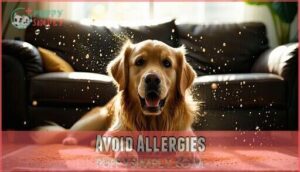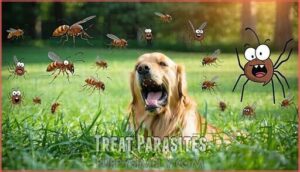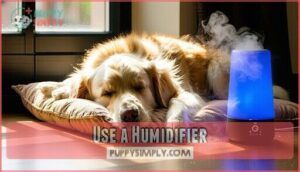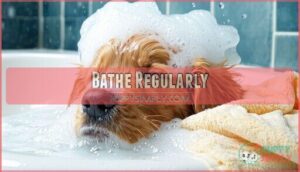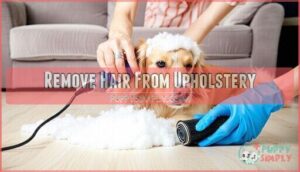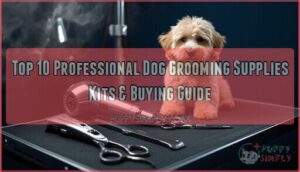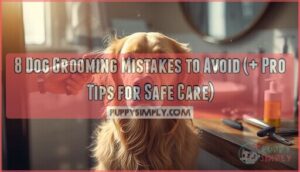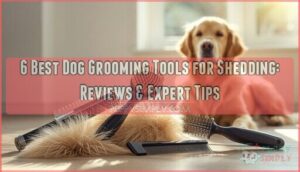This site is supported by our readers. We may earn a commission, at no cost to you, if you purchase through links.

Start with proper nutrition—feed omega-3 rich foods and balanced protein to strengthen hair follicles. Brush daily using the right tools for your pet’s coat type, following hair growth direction.
Create quiet spaces to minimize stress, which triggers hair loss. Control allergens through regular vet checkups and medicated baths when needed.
Maintain 30-60% humidity levels and bathe every 4-6 weeks with gentle products. Most importantly, treat parasites like fleas that cause scratching and hair damage.
These evidence-based strategies can cut shedding by up to 40% within weeks.
Table Of Contents
- Key Takeaways
- Reduce Stress
- Brush Regularly
- Feed a Healthy Diet
- Take Supplements
- Avoid Allergies
- Treat Parasites
- Use a Humidifier
- Bathe Regularly
- Use The Right Brush
- Remove Hair From Upholstery
- Frequently Asked Questions (FAQs)
- What is the best way to reduce stress for my dog?
- What type of brush should I use for my dog’s hair?
- What supplements can help to reduce hair loss in dogs?
- How can I avoid allergies that cause hair loss in my dog?
- How often should I vacuum pet hair?
- When should I see a veterinarian?
- Do seasonal changes affect pet shedding?
- Can indoor lighting impact hair loss?
- What fabrics repel pet hair best?
- Conclusion
Key Takeaways
- Feed your pet omega-3 rich foods and balanced protein – you’ll strengthen hair follicles and can reduce shedding by up to 40% within weeks through proper nutrition
- Brush daily with the right tool for your pet’s coat type – you’ll remove 80% more loose hair compared to weekly sessions and prevent matting that causes breakage
- Create quiet spaces and reduce stress triggers – you’ll minimize anxiety-related hair loss since stress acts as a hidden trigger for excessive shedding
- Control parasites like fleas and use monthly preventatives – you’ll eliminate 98% of hair fall caused by scratching and skin irritation from these tiny invaders
Reduce Stress
Stress acts like a hidden trigger for excessive shedding in pets.
Create a calming environment by establishing quiet spaces where your furry friend can retreat. Regular exercise benefits both mental and physical health, reducing anxiety that leads to hair fall.
Combat separation anxiety with mental stimulation through puzzle toys and interactive games. Your own wellbeing matters too—stressed owners often have stressed pets.
Consider calming treats containing natural ingredients when environmental changes occur. Consistent routines help reduce stress in dogs substantially.
You can also try synthetic pheromone diffusers to mimic calming signals and promote a peaceful atmosphere for your pet.
Brush Regularly
Brushing regularly keeps loose fur off your furniture and helps your pet’s coat type stay healthy.
Choose the right deshedding tool for your pet’s specific needs.
Daily grooming frequency prevents matting and reduces shedding by sixty percent.
Use proper brushing technique by following hair growth direction.
Professional grooming every few months maintains coat health perfectly.
Regular brushing helps distribute natural oils effectively.
Feed a Healthy Diet
Nutrition becomes your pet’s foundation for strong, healthy fur.
Quality diets rich in Essential Fatty Acids like omega3 strengthen hair follicles while reducing hair fall substantially.
Balanced Pet Diets containing adequate protein support keratin production.
Grain-Free Foods help sensitive pets avoid allergens that trigger excessive shedding.
Include Vitamin Rich Treats and consider Biotin Supplements for ideal coat health through proper nutrition.
Skin and coat problems account for many vet visits due to poor nutrition.
Take Supplements
Strategic supplement choices can transform your pet’s coat health when natural shedding becomes excessive. Research shows that targeted nutritional support addresses hair loss at its root cause.
The right supplements can be your pet’s secret weapon against excessive shedding and poor coat health
Omega-3 Benefits shine through fish oil supplementation, reducing shedding rates by up to 32% in clinical trials. These essential fatty acids strengthen hair follicles and improve skin barrier function.
Consider these proven supplements for optimal coat health:
- Fish oil – Provides omega-3 fatty acids for stronger, shinier fur
- Biotin – B vitamin essential for keratin production and hair growth
- Zinc – Supports follicle health and reduces excessive shedding
- Vitamin E – Protects skin cells from oxidative damage
- Multivitamins – Address nutritional gaps that contribute to hair loss
Biotin Dosage typically ranges from 5 mcg per kg of body weight daily. However, Veterinary Approval remains vital before starting any regimen. Supplement Interactions can occur with existing medications, making professional guidance essential. Notably, supplements lack oversight, increasing the risk of harmful substances.
Remember that Coat Specifics vary by breed – double-coated dogs may need higher doses than short-haired cats. Quality matters more than quantity when selecting supplements for your furry friend.
Avoid Allergies
Around 16% of dog insurance claims relate to skin allergies, making allergen management essential for reducing hair loss.
Skin allergies trigger 16% of dog insurance claims—your pet’s coat depends on smart allergen management
When your pet’s immune system overreacts to specific triggers, excessive scratching and shedding follow. Owners should also consider that pet hair carries dander, a common source of allergens.
Identify allergens through careful observation and vet checkups. Common culprits include:
- Food sensitivities to proteins, grains, or additives
- Environmental allergies from pollen, dust mites, or mold
- Flea control issues causing skin irritation
- Contact allergens like cleaning products or fabrics
- Seasonal triggers that worsen during specific months.
Medicated baths help remove surface allergens while soothing inflamed skin. Your vet can recommend hypoallergenic shampoos that won’t strip natural oils.
Treat Parasites
Parasites like fleas and ticks cause 98% of hair fall through excessive scratching. These tiny invaders create bald patches and skin irritation that worsens without treatment.
- Flea control: Use monthly preventatives for 99% effectiveness within two weeks
- Tick prevention: Apply topical treatments providing 30-day protection against infestations
- Mite treatment: Schedule vet checkups for proper diagnosis and prescribed medications
- Medicated baths: Use antiparasites treatments and deworming schedule as recommended. Consider integrative veterinary medicine for a thorough approach.
Use a Humidifier
A humidifier creates ideal humidity levels that keep your pet’s skin moisturized and healthy. Dry indoor air strips natural oils from their coat, leading to dandruff and increased hair loss. Use a humidifier for pets in rooms where they spend most time.
Using a humidifier can help to keep your pet’s skin hydrated, which can:
- Prevent dandruff and reduce static reduction in their coat
- Improve air quality while providing sinus relief for respiratory comfort
- Minimize pet hair breakage by maintaining moisture in the hair shaft
To use a humidifier, simply:
- Fill it with water and maintain 30-60% humidity levels
- Place it in rooms where your pet spends significant time
Clean the humidifier regularly to prevent bacteria growth and guarantee fresh air circulation. You can also apply coconut oil, which acts as a natural repellent, to further protect your pet.
Bathe Regularly
Regular baths can cut your pet’s hair fall by up to 40%. Bathe pets regularly every 4-6 weeks using lukewarm water and gentle shampoo to avoid stripping natural oils.
For pets with skin infections, medicated shampoo works best. Always follow with conditioner for moisture and easier brushing.
Bathing frequency depends on several factors. coat type
Bathing frequency matters:
- Use lukewarm water – Hot water dries skin and worsens shedding
- Choose gentle shampoo – Harsh chemicals irritate and increase hair loss
- Apply conditioner – Moisturizes skin and reduces breakage
Use The Right Brush
Your pet’s coat type determines which brush works best.
Slicker brushes excel for long-haired breeds, removing tangles and preventing mats.
Bristle brushes suit short-haired pets perfectly, spreading natural oils for a healthier shine.
Double-coated breeds need undercoat rakes that target shedding layers effectively.
Brush size matters too.
Larger brushes cover more ground on big dogs, while smaller ones work better for cats and tiny breeds.
The bristle material should match your pet’s sensitivity level – softer bristles for delicate skin, firmer ones for thick coats.
Daily brushing with proper grooming tools reduces loose hair by 80% compared to weekly sessions.
Deshedding tools like specialized combs remove up to 90% more fur during seasonal changes.
Using the wrong brush can actually increase hair fall by causing skin irritation, so match your grooming frequency to your pet’s specific needs.
For double coated breeds, consider using deshedding and dematting tools to remove loose fur.
This approach helps in reducing shedding and prevents skin irritation by choosing the right brush type and size, ensuring a healthier shine and a well-groomed pet with less matting and tangling.
Remove Hair From Upholstery
Effective pet hair removal starts with the right tools and techniques.
Lint rollers work well for quick touch-ups on fabric surfaces. Vacuum attachments designed for upholstery penetrate deeper into cushions.
Pet hair magnets like rubber gloves create static that pulls stubborn fur from different upholstery types. For serious pet hair reduction, invest in a quality pet hair remover tool specifically designed for furniture cleaning.
Regular brushing with a deshedding tool can also minimize hair on furniture, using the right techniques and tools for effective pet hair removal.
Frequently Asked Questions (FAQs)
What is the best way to reduce stress for my dog?
Create a calm environment with consistent routines, provide mental stimulation through puzzle toys, make certain adequate exercise, and consider calming aids like pheromone diffusers or anxiety wraps during stressful situations.
What type of brush should I use for my dog’s hair?
Choose your brush based on your dog’s coat type.
Slicker brushes work best for double-coated breeds, while bristle brushes suit short-haired dogs.
Daily brushing with the right tool removes loose hair effectively.
What supplements can help to reduce hair loss in dogs?
Beneficial biotin and fish oil supplements strengthen your dog’s coat from within.
These omega-3 fatty acids and vitamin supplements reduce excessive shedding by up to 30% when added to balanced diets consistently.
How can I avoid allergies that cause hair loss in my dog?
Identify your dog’s allergens by monitoring for fleas, mites, and food triggers.
Use regular flea medication, avoid known irritants, and schedule vet checkups to catch skin infections early before they worsen shedding.
How often should I vacuum pet hair?
You should vacuum pet hair at least twice weekly, or daily during heavy shedding seasons. High-traffic areas need more attention. Regular vacuuming removes up to 60% of loose fur.
When should I see a veterinarian?
When warning bells ring louder than your pet’s purr, it’s time for professional help.
See your vet if excessive shedding persists beyond seasonal changes, bald patches appear, or scratching becomes constant.
Do seasonal changes affect pet shedding?
Yes, seasonal changes substantially affect pet shedding.
Your pet sheds more in spring and sometimes fall as they naturally replace their coats.
Double-coated breeds take thirty to forty-five days to fully shed and regrow their fur during these seasonal shifts, which is a key aspect of their natural replacement process.
Can indoor lighting impact hair loss?
While you might think lighting doesn’t matter, indoor bulbs disrupt your pet’s natural circadian rhythm. Pets need proper light cycles to regulate hormones that control shedding patterns naturally.
What fabrics repel pet hair best?
Choose smooth fabrics like microfiber, leather, or tightly woven cotton.
These materials don’t grab onto pet hair like fuzzy textures do.
Avoid velvet, corduroy, and fleece – they’re hair magnets that’ll leave you constantly cleaning.
Conclusion
Managing excessive shedding versus accepting natural hair loss shows the difference between proactive pet care and reactive cleanup.
You’ve learned ten proven methods to reduce hair fall of your pet through proper nutrition, regular grooming, stress management, and parasite control.
These strategies work together to strengthen your pet’s coat from the inside out, starting with daily brushing and high-quality food, then adding other techniques gradually.
Most pet owners see noticeable improvements within two to four weeks of consistent application.
- https://www.bhg.com/best-way-to-remove-pet-hair-from-couch-6891198
- https://www.instagram.com/p/DL2JjEqoX1d/?locale=en_US%2Cen_GB%2Cen_GB
- https://vcahospitals.com/know-your-pet/the-importance-of-your-pets-skin-and-coat-and-the-role-of-diet
- https://www.urbanpethospital.com/blog/post/Things-that-can-be-done-to-Prevent-Hair-Loss-in-Pets
- https://pubmed.ncbi.nlm.nih.gov/38625527/



